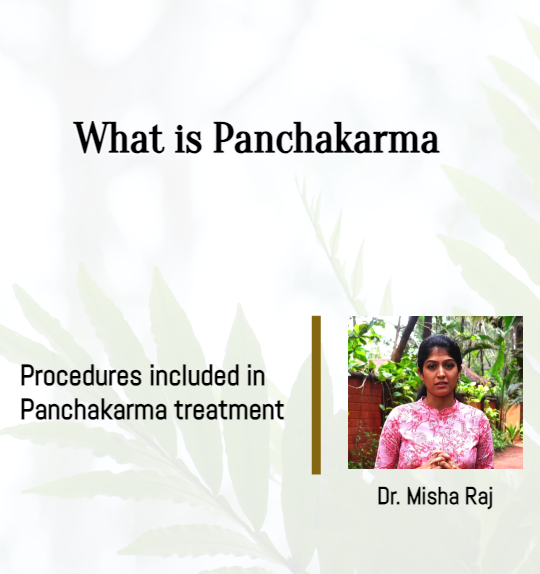Panchakarma Detoxification
Panchakarma Treatment following the classical method (As per ancient treatises)
We are highly regarded as the best ayurvedic center in Kerala for delivering authentic panchakarma treatments in Kerala. We utilize both ancient and modern techniques to provide the finest Ayurvedic therapies available. Five major procedures to eliminate toxins from the nearest orifice are popularly called Panchakarma. Panchakarma treatment includes a set of five therapeutic treatments administered to the patient for the deeper and complete detoxification of the body. The presence of toxins which is accumulated, in the physical, pranic, and mental dimensions from past life accumulations, from the parents, society, improper diet, improper lifestyle, and living without awareness causes not fulfilling the purpose of creation in this universe. According to Ayurveda, detoxification is essential before undergoing any other major treatment. Even for healthy people, it is recommended to undergo this treatment once every 5 years to get rid of all the chemical toxins accumulated over the years. In some cases, Panchakarma treatment alone can use to treat many chronic diseases that will not require any further treatments afterward.
Enquire Now
Procedures included in Panchakarma treatment
Purvakarma (Preparatory procedures before Panchakarma – detoxification treatment)- Deepana – Pachana chikitsa
- Snehana
- Swedana
- Vamana
- Virechana
- Asthapana Vashti
- Anuvasana vasti
- Nasya
- Samsarjanakrama ( Special diet )
- Drugs
- Regimens
Note :
Acharya sushrutha mentioned Asthapana vasti and Anuvasana vasti under the heading of Vasti. He included Rakta mokshana (bloodletting) as the 5th purification treatment in Panchakarma (detoxification treatments). Raktha mokshana is a procedure of removing the vitiated blood, in diseases caused by rakta and pitta. This therapy will be done only in accordance with the patient’s condition.
Receiving authentic Panchakarma – detoxification treatments as per the classical way, requires 90-120 days. Each and every procedure will be monitored. By observing samyak lakshanas (the symptoms of proper saturation) then only the next treatment will be started.
Purvakarma
Preparatory procedure
Before the actual Panchakarma – detoxification begins, there is a need to prepare the body with prescribed methods to encourage dislodging toxins from deeper levels.
Deepana pachana chikitsa
Agni (digestive fire ) is the most important parameter to be considered before starting panchakarma – detoxification treatments. Without a proper functional state of digestive fire, snehapana (oleation) does not give the desired results. It can lead to complications.
- Deepana Pachana treatments enhance the Agni ( Digestive fire )
- Ama pachana ( Clears the metabolic toxins )
Thus it helps in better digestion and absorption. It reduces the risk of complications.
- Snehana (Oleation therapy)
Snehana is the immediate treatment after Deepana – Pachana. It can be done internally and externally.
Snehapana is the oral intake of medicated or non-medicated fat in required quantities. It helps to saturate the toxins before doing Vamana (Therapeutic vomiting) and virechana (Therapeutic purgation). It requires 3-7 days according to the state of vitiation of doshas and the individual’s constitution.
Abhyanga is an external oil massage. After observing the proper signs of saturation of snehapana, Abhyanga should be done prior to Vamana and virechana.
- Swedana (Sudation Therapy)
The process of inducing sweat through various procedures is known as swedana. Baspa sweda (Steam) is usually given before panchakarma.
Swedana helps to mobilize the saturated toxins and then move from different parts of the body to the middle part of the body.
Abyanga and swedana (Steam) are the preparatory procedure of all the panchakarma – detoxification treatments. Based on the panchakarma (detoxification) procedure both are giving the whole body or local parts.
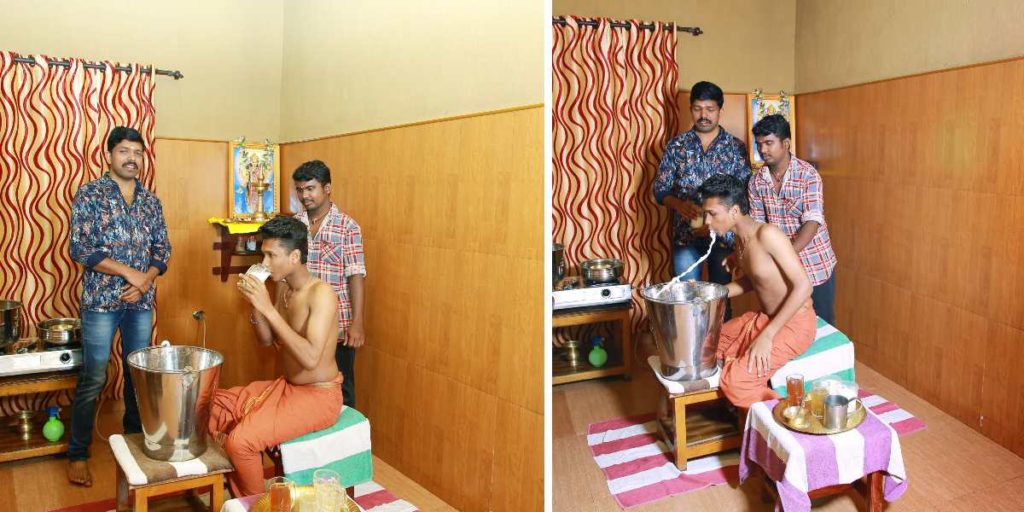
Vamana
Therapeutic Vomiting
Vamana is the process of cleansing the upper part of the body (Stomach, Lungs, etc..) through the oral route by inducing vomiting. It helps to balance Kapha dosha.
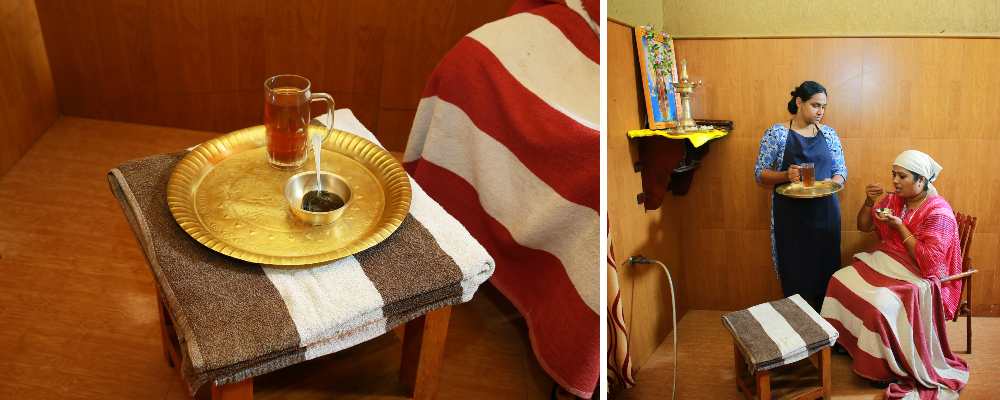
Virechana
Therapeutic purgation
Virechana is the process of evacuation of accumulated doshas in the lower gastrointestinal tract through the anal route. It removes pitta dosha from the body. It completely cleanses the gastrointestinal tract.

Asthapana Vasti
Herbal decoction enema
The administration of Vasti predominantly consisting of herbal decoction through the rectal route is known as Asthapana Vasti. It includes herbal decoction, medicated oil, honey, rock salt, herbal powder, etc. It is also known by the name Niruha vasti.
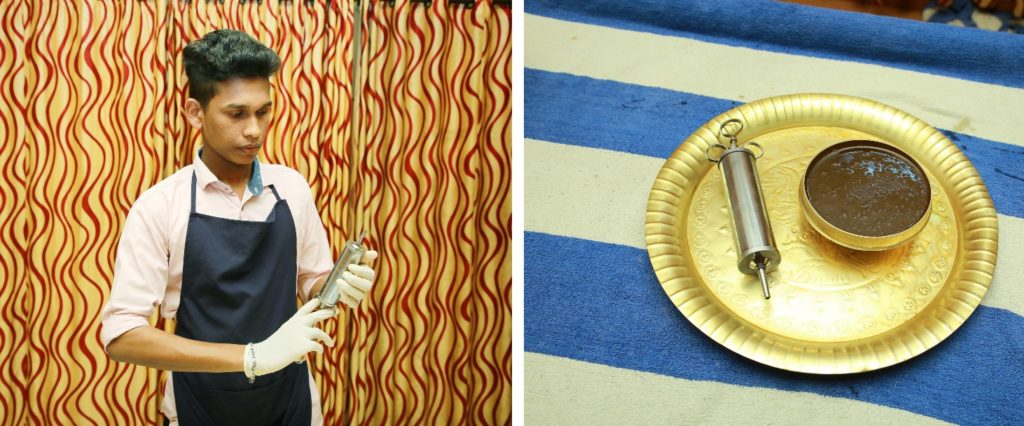
Anuvasana Vasti
Medicated oil Enema
Administration of medicated oil or fat through the rectal route in a prescribed dose. Both (Asthapana vasti and Anuvasana vasti) vasti help to subside the vata dosha in our body. Vata dosha is predominant in the colon. It cleanses the colon.
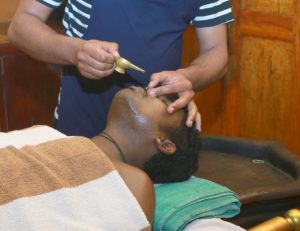
Nasya
Nasal Therapy
It is the nasal administration of medicine in the form of medicated oil or herbal juice extract or herbal powder or herbal smoke. The nose is the doorway to the brain. Administration of medicine through the nose cleanses the accumulated Kapha from the head and neck. PASCHAT KARMA (Post procedures after Panchakarma – detoxification treatments)
Samsarjanakrama
After Vamana and Virechana, jatharagni (Digestive fire) gets diminished. Samsarjanakrama is performed to augment this diminished Agni (Digestive fire). When all the Agni (digestive fire) remains in a normal state, then there is normal production of all dhatus (Tissue elements) and respective malas (waste products).
Categorization of days in the Panchakarma – detoxification procedure
| Sl: No | Treatments | No: of Days | Procedure |
| 1 | Deepana Pachana Chikitsa (For improving digestive fire and for eliminating metabolic toxins) | It will be continued till the proper symptoms are present. | External treatments and Internal medications |
| 2 | Snehapana (Oleation therapy) | 3-7 days (Depends on the symptoms of saturation). | Intake of medicated Ghee, No other treatments and Medications |
| 3 | Resting Day | 1 day | Diet, Abhyanga (Oil massage) and Bashpa Sweda (Steam). |
| 4 | Vamana karma (Therapeutic vomiting) | 1 Day | Abhyanga (Oil massage), Bashpa Sweda (Steam) and therapeutic vomitting |
| 5 | Samsarjanakrama (Post dietic regimen) | 7 Days | Diet, external therapies, Internal medications |
| 6 | Snehapana (Second course of oleation) | 3 – 7 Days | Intake of medicated Ghee, No other treatments and Medications |
| 7 | Resting Days | 2 – 3 Days | Diet, Abhyanga (Oil massage) and Bashpa Sweda (Steam). |
| 8 | Virechana Karma (Therapeutic purgation) | 1 Day | Abhyanga (Oil massage), Bashpa Sweda (Steam), and therapeutic purgation. |
| 9 | Samsarjanakrama (Post dietic regimen) | 7 Days | Diet, external therapies, internal medications |
| 10 | Vasti Karma (Therapeutic enema) (Asthapana Vasti – decoction enema or Anuvasana Vasti – Oil enema or combined) | 8 Days | Along with Enema, Internal Medicines, and Other External Therapies |
| 11 | Resting Days | 16 Days | Along with Nasal Therapy, Internal Medicines, and External Therapies |
| 12 | Nasya Karma (Major administration of medicine) | Till the proper symptoms of Nasya. | Along with Nasal Therapy, Internal Medicines, and External therapies |
Note:
If the patient is having 90-120 days time duration for treatment, then the only authentic classical way of panchakarma – detoxification treatments will be possible. Otherwise, if you have a lesser duration of treatments, on the basis of assessment, the required cleansing treatments among the panchakarma (detoxification) will be provided.
Along with the main Panchakarma – detoxification procedures different external therapies are included according to the individual condition. This includes local treatments and also whole-body treatments.
External therapies (From the below-mentioned treatments, on the basis of the individual’s condition, procedures will be selected)
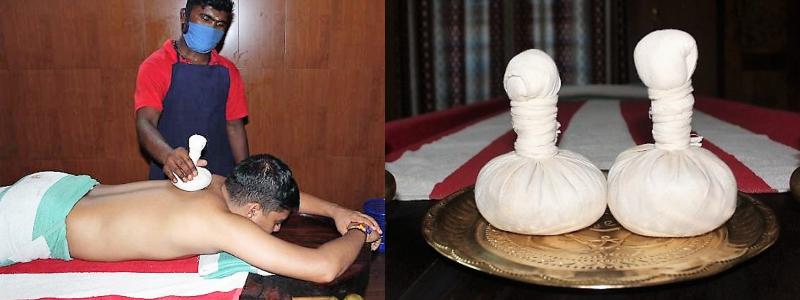
-
Abhyanga :– Oil massage
-
Udwartana :– Powder massage
-
Dhara :– Pouring medicated liquids all over the body.
-
-
Kashaya dhara:– Pouring medicated decoction.
-
Dhanyamla Gomutra dhara:– Pouring fermented cereals with Cow’s Urine.
-
Ksheera dhara:– Pouring medicated milk.
-
Gomutra dhara:– Pouring cow’s Urine.
-
Takra dhara:– Pouring medicated butter milk.
-
Thaila dhara:– Pouring medicated oil.
-
-
Kizhi (Pinda sweda):– Sudation done by using heated packs.
-
-
Shashtikashali pinda sweda (Njavara kizhi):– Pack of special cooked rice with medicated milk.
-
Jambeera pinda sweda :– Pack of lemon.
-
Mamsa pinda sweda :– Pack of meat.
-
Valuka sweda :– Pack of Sand.
-
Dhanya pinda sweda :– Pack of cereals, horse gram, black gram etc..
-
Choorna pinda sweda :– Pack of herbal powder.
-
-
Avagaha :– Immersing the body in herbal decoction or medicated oil.
All the above treatment can be done locally or whole body.
-
Bashpa Sweda (Steam treatment):– Patient made to sit in a steam chamber.
-
Nadi sweda :– Sudation done by passing steam over the body parts by using a tube attached to a kettle.
-
Shiro dhara :– Medicated oil, herbal decoction, medicated milk, medicated butter milk etc.. continuously pour on the forehead.
-
Shiro pichu :– Cotton soaked with suitable oil and placed on the head.
-
Shiro Vasti :– Pool of medicated oil is allowed to stay over the head for a prescribed time.
-
Shiro lepa (Thala pothichil):– Paste application over the head.
-
Lepam :– Herbal paste application.
-
Mukha lepam :– Face pack.
-
Upanaha :– Paste application with bandaging.
-
Kati Vasti :– Pool of luke warm oil is allowed to stay over the lower back.
-
Janu Vasti :– Pool of luke warm oil is allowed to stay over the knee joint.
-
Greeva Vasti :– Pool of luke warm oil is allowed to stay over the cervical region.
-
Uro vasti :– Pool of luke warm oil is allowed to stay over the cardiac region.
-
Dhoopanam :– Nasal fumigation.
-
Karna Dhoopanam :– Ear fumigation.
-
Netra Tarpanam :– Pool of medicated ghee is allowed to stay over the eyes.
-
Karnapooranam :– Droping the medicated oil into the ears.
-
Netra prakshalanam :– Eye wash with medicated liquid.
-
Karna prakshalanam :– Ear wash with medicated liquid.
-
Yoni Prakshalanam :– Vaginal wash with medicated liquid.
-
Kavalam :– Holding medicated oil or herbal decoction in the buccal cavity followed by gargling for a certain period.
-
Gandoosha :– Holding medicated oil or herbal decoction in the buccal cavity for a certain period.
-
Bidalaka :– Herbal paste is to be applied over the eyelid.
-
Pindi :– Massage around the eyes with a very small medicated pack.
-
Ashchyotana :– Pouring medicated drops into the eyes.
-
Anjanam :– Medicine in the form of powder, paste or liquid is to be applied inside the lower lid of the eyes.
-
Pudapaka :– Maintain the prescribe juice of medicinal plants for specific time.
-
Varti Prayogam :– Suppositories.
Experience the Benefits of Panchakarma Treatment
Panchakarma, an ancient healing technique, offers a holistic approach to rejuvenating the mind and body. In this article, we will explore the philosophy behind Panchakarma, the five therapies involved, and the numerous physical and mental benefits it brings. We will also delve into how to prepare for the treatment, what to expect during the process, and debunk common myths associated with Panchakarma.
Understanding Panchakarma: An Ancient Healing Technique
Panchakarma, derived from Sanskrit, translates to “five actions” or “five treatments.” Rooted in Ayurveda, the traditional Indian system of medicine, Panchakarma aims to restore balance and promote overall wellness. It is based on the belief that when our bodies accumulate toxins or impurities, we become susceptible to illness and imbalances.
The Philosophy Behind Panchakarma
At the heart of Panchakarma is the belief that our physical, mental, and spiritual well-being are interconnected. According to Ayurveda, our bodies have three doshas: Vata, Pitta, and Kapha. When these doshas are in balance, we experience health and vitality. However, factors such as stress, poor diet, and environmental toxins can disrupt this equilibrium, leading to imbalances and health issues. Panchakarma aims to eliminate these imbalances and restore harmony.
Ayurveda views the body as a microcosm of the universe, with each individual being a unique combination of the five elements: earth, water, fire, air, and ether. These elements manifest in the body as the doshas, and their balance is crucial for optimal health. Panchakarma recognizes that imbalances in the doshas can lead to various physical and mental ailments. By addressing these imbalances through the five therapies, Panchakarma seeks to bring the body back into its natural state of equilibrium.
The Physical and Mental Benefits of Panchakarma
Panchakarma offers a wide range of benefits for both the physical and mental well-being. Here are some of the advantages:
Detoxification and Rejuvenation
Panchakarma helps to eliminate accumulated toxins from the body, promoting detoxification and rejuvenation. By cleansing the organs, tissues, and channels, it enhances the body’s natural healing mechanisms and improves overall vitality. This purification process also boosts the immune system, making it more resilient against diseases.
During the detoxification process, Panchakarma targets specific areas of the body, such as the digestive system, liver, and lymphatic system. By removing toxins from these vital organs, it allows them to function optimally, leading to improved digestion, increased energy levels, and a stronger immune system.
Furthermore, Panchakarma not only focuses on physical detoxification but also on mental and emotional detoxification. The therapies and treatments involved in Panchakarma help release emotional blockages and promote a sense of mental clarity and well-being.
Stress Reduction and Emotional Balance
In today’s fast-paced world, stress and emotional imbalances have become common. Panchakarma offers a therapeutic approach to combat stress and restore emotional balance. The treatments help to calm the mind, release pent-up emotions, and induce deep relaxation. This not only helps in managing stress but also improves sleep quality and promotes mental clarity.
One of the key components of Panchakarma is the practice of meditation and mindfulness. These techniques help individuals develop a greater sense of self-awareness and enable them to manage stress more effectively. By incorporating these practices into their daily lives, individuals can experience long-term emotional balance and resilience.
Moreover, Panchakarma includes various Ayurvedic therapies such as Abhyanga (oil massage), Shirodhara (pouring of warm oil on the forehead), and Swedana (herbal steam therapy). These therapies not only provide physical relaxation but also have a profound effect on the mind and emotions. They help release tension, promote a sense of well-being, and restore harmony within the body and mind.
In conclusion, Panchakarma offers numerous physical and mental benefits. From detoxification and rejuvenation to stress reduction and emotional balance, this ancient Ayurvedic practice provides a holistic approach to overall well-being. By incorporating Panchakarma into your lifestyle, you can experience improved vitality, enhanced immune function, and a greater sense of peace and harmony.
Preparing for Your Panchakarma Treatment
Before undergoing Panchakarma, it is essential to prepare your body and mind. Here are a few crucial steps to take:
Initial Consultation and Assessment Schedule a consultation with a qualified Ayurvedic practitioner who specializes in Panchakarma. They will assess your current health status, identify any imbalances, and tailor the treatment plan to meet your unique needs. It’s important to provide a comprehensive medical history to ensure a safe and effective experience.Dietary and Lifestyle Adjustments
Your Ayurvedic practitioner will guide you on necessary dietary and lifestyle adjustments to enhance the effectiveness of Panchakarma. These adjustments typically involve following a simple and healthy diet, avoiding processed foods, and incorporating relaxation techniques like yoga and meditation into your routine. By making these changes, you create an optimal environment for the healing process to unfold.
What to Expect During Panchakarma Treatment
Once you are prepared for Panchakarma, it’s important to understand what to expect during the treatment process. Here is an overview:
The Treatment Process
Panchakarma is typically performed in a specialized Ayurvedic clinic or retreat center under the supervision of trained therapists. The duration of each therapy and the overall treatment plan will vary depending on individual needs. During the treatments, you can expect to experience a combination of oil massages, steam baths, herbal remedies, and other therapeutic techniques customized to your requirements.
Post-Treatment Care and Maintenance
After completing the Panchakarma treatment, it is crucial to follow post-treatment care guidelines provided by your Ayurvedic practitioner. These guidelines may include dietary recommendations, herbal supplements, and lifestyle suggestions to maintain the balance achieved during the treatment. Adhering to these guidelines ensures long-lasting benefits and prevents the reintroduction of toxins into your body.
Debunking Common Myths About Panchakarma
Panchakarma, like any other traditional healing practice, is often surrounded by misconceptions. Let’s address some of the common myths:
Safety and Efficacy of Panchakarma
Contrary to popular belief, Panchakarma is a safe and highly effective therapy when administered by qualified professionals. The therapies are tailored to individual needs, ensuring that they are gentle yet powerful. However, it is crucial to consult an experienced Ayurvedic practitioner and follow their guidance throughout the treatment process.
Panchakarma and Modern Medicine: A Comparison
Some individuals may question the effectiveness of Panchakarma when compared to modern medical treatments. It’s important to understand that Panchakarma and modern medicine operate on different paradigms. While modern medicine focuses on symptom management and disease treatment, Panchakarma emphasizes the restoration of balance and overall well-being. Both approaches have their merits and can be complementary depending on the individual’s needs.
Experience the Holistic Benefits of Panchakarma
Panchakarma offers a profound healing experience for those seeking a holistic approach to wellness. By understanding the philosophy behind Panchakarma, harnessing its five therapies, and preparing for the treatment with the guidance of an Ayurvedic practitioner, you can unlock numerous physical and mental benefits. Moreover, debunking common myths surrounding Panchakarma enables you to embrace this ancient healing technique with confidence. Embark on a transformative journey by experiencing the benefits of Panchakarma treatment today.
DAILY SCHEDULE
The following schedule has been designed for receiving the optimum benefit at physical, pranic, and mental levels.
- Every day morning wakes up around 4.30 am.
- When awake, practice seven rounds of deep breathing.
- Slowly sit on the bed and focus your mind on positive thoughts.
- Then get up and do brushing and tongue cleaning.
- Do oil pulling using sesame oil, for eliminating lodged toxins from the oral cavity.
- Drink warm water.
- Take shower.
- Wear washed and clean cloth.
- Yoga Session – 5.00 am – 6.15 am
- Morning Pooja(Agnihotram) – 6.30 am – 7.30 am
- Breakfast – 8.00 am – 9.00 am
- Treatment session – (Mentioned in our Notice board -Restaurant.)
- Consultation time – (Mentioned in our Notice board-Restaurant.)
- Yoga Nidra Session – 12.00 pm – 01:00 pm
- Lunchtime – 01.00 pm – 1.30 pm
- Kalari session – 11.00 am – 12.00 noon , 3.00 pm – 4.00 pm
- Evening Yoga – 4.00 Pm – 5.15 Pm
- Anna Pooja – 5.15 Pm – 5.30 Pm
- Dinner session – 5.30 pm – 6.00 pm
- Evening pooja & chanting – 6.00 pm – 7.00 pm
- Bhajans – 6.30 pm (Every Monday & Friday)
- Every Friday at 05:15 am Lalitha Sahasranama yajna will be conducted ( No regular morning yoga on Friday)
- No Yoga Nidra on Sunday
Reasons for the absence must be brought to the notice of your respective teacher and doctor immediately.
INSTRUCTIONS FOR MAKING YOUR STAY EFFECTIVE
❖ The diet and lifestyle are planned by our doctors in accordance with classical Ayurvedic methods.
❖ Do not take tea or coffee while taking treatments, as it reduces the effect of internal medicines.
❖ Diet is very important like, Yoga and treatment. So please maintain silence while taking food.
❖ During treatment time, avoid using lots of exposure to sound, wind, overstraining in front of the computer, irrelevant talking, and daytime sleep. If you face any difficulties mention it to your doctor while coming for a consultation.
❖ Take permission from the concerned Physician before making traveling during the treatment Phase, as traveling may result in adverse effects.
❖ If there is any emergency during the stay please contact
Reception: +91 9539684635
Restaurant : +91 9656901643
Reservation : +91 8157011347
AYV Doctors Team
Weekly programs:
1) Organic vegetable farm and Cattle farm visit: Every Monday and Tuesday at 2.45 PM
2) Pharmacy visit: Every Wednesday at 7:30 AM
3) Musical meditation sessions (BAJAN) every Monday and Friday at 6:30 PM
Some changes will be made in the daily schedule by the doctor according to the phase of Panchakarma – detoxification treatments.

